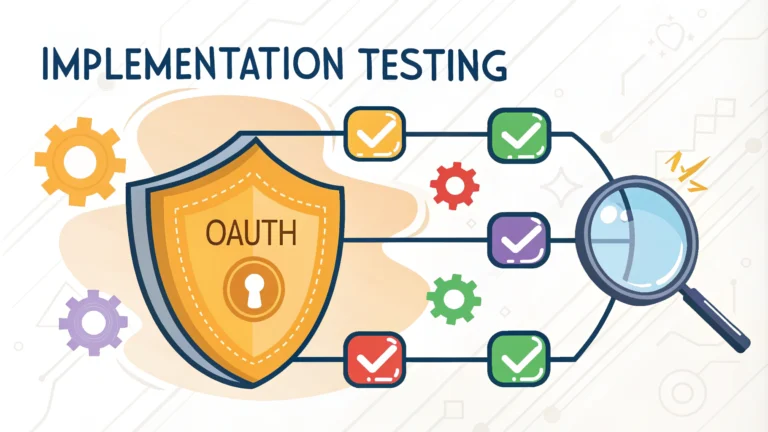OAuth penetration testing helps organizations identify security weaknesses in their OAuth implementations before malicious actors can exploit them.
Testing OAuth configurations requires understanding both the authentication flow mechanics and common vulnerability patterns that attackers target.
This guide explores key OAuth security testing techniques, common vulnerabilities, and remediation strategies to help secure OAuth implementations.
Essential OAuth Testing Areas
- Authorization code flow validation
- Token handling and storage
- Redirect URI validation
- Scope permissions testing
- Client credentials security
Authorization Code Flow Testing
Check for authorization code reuse by attempting to exchange the same code multiple times.
Test code interception by modifying redirect URIs to point to attacker-controlled endpoints.
Verify PKCE (Proof Key for Code Exchange) implementation for mobile and native applications.
Token Security Testing
- Access Token Tests:
- Verify token expiration enforcement
- Test token revocation mechanisms
- Check for token leakage in logs
- Refresh Token Tests:
- Validate rotation policies
- Test replay protection
- Check storage security
Common OAuth Vulnerabilities
| Vulnerability | Testing Method |
|---|---|
| Redirect URI Manipulation | Try adding wildcards, different paths, or subdomains |
| CSRF Attacks | Test state parameter validation |
| Scope Escalation | Modify scope parameters during requests |
Testing Tools
- Burp Suite – OAuth specific extensions available
- OWASP ZAP – Built-in OAuth testing features
- Postman – OAuth workflow testing
Security Best Practices
Implement strict CORS policies to prevent unauthorized cross-origin requests.
Use secure communication channels (HTTPS) for all OAuth-related traffic.
Employ short-lived access tokens with proper refresh token rotation.
Documentation Requirements
- Record all test cases and results
- Document vulnerability findings with proof of concept
- Include remediation recommendations
- Track fixes and retest results
Next Steps for OAuth Security
Regular penetration testing should be part of your OAuth security maintenance program.
Keep up with OAuth security updates and patches from official sources.
Consider engaging with the OAuth security community for latest testing methodologies and tools.
Automated Testing Strategies
Integrate OAuth security testing into CI/CD pipelines for continuous validation.
Develop custom test scripts to automate repetitive security checks.
Key Automation Areas
- Token lifecycle validation
- Authorization flow integrity
- Configuration drift detection
- Security header verification
Response Handling Validation
Test error responses to ensure they don’t leak sensitive information.
Verify proper handling of invalid tokens and expired credentials.
- Error Scenarios to Test:
- Invalid client credentials
- Malformed requests
- Rate limiting responses
- Token revocation events
Compliance Testing
Ensure OAuth implementation meets relevant regulatory requirements.
| Standard | Key Requirements |
|---|---|
| GDPR | User consent, data handling |
| PSD2 | Strong authentication, API security |
| HIPAA | Access controls, audit logging |
Strengthening OAuth Security Posture
Implement continuous monitoring and regular security assessments to maintain robust OAuth security.
Establish incident response procedures specific to OAuth-related security events.
- Maintain detailed security documentation
- Review and update security policies regularly
- Train development teams on OAuth security best practices
- Stay informed about emerging OAuth threats and mitigations
Build a comprehensive testing strategy that evolves with your OAuth implementation and security landscape.
FAQs
- What are the most critical OAuth vulnerabilities to test for during penetration testing?
Insufficient redirect URI validation, client secret exposure, token leakage, insecure token storage, CSRF attacks on authorization endpoints, and improper state parameter implementation. - How can I test for improper OAuth scope validation?
Test by manipulating scope parameters during authorization requests, attempting to escalate privileges by modifying scope values, and verifying if the application properly validates and restricts scope access. - What tools are commonly used for OAuth penetration testing?
Burp Suite Professional, OWASP ZAP, Postman for API testing, OAuth 2.0 Debugger, and custom scripts for token manipulation and automated testing. - How do I test for OAuth token leakage in browser history?
Examine browser history entries, URL parameters, and referrer headers to ensure tokens aren’t exposed in URLs, and verify that tokens are transmitted securely through request body or headers. - What methods can detect OAuth authorization code interception?
Test PKCE implementation, verify SSL/TLS configuration, check for code reuse vulnerabilities, and attempt code interception through manipulated redirect URIs. - How should I test OAuth refresh token security?
Verify refresh token rotation, check expiration policies, test for token reuse after refresh, and ensure secure storage and transmission of refresh tokens. - What are the key areas to test in OAuth client authentication?
Test client ID and secret validation, verify secure storage of credentials, check for proper implementation of client authentication methods, and assess certificate validation for private key JWT authentication. - How can I test for OAuth cross-site request forgery vulnerabilities?
Verify state parameter implementation, test CSRF token validation, check for proper session binding, and attempt login CSRF attacks on the authorization endpoint. - What should I check when testing OAuth redirect URI validation?
Test for open redirectors, verify whitelist enforcement, check for path traversal vulnerabilities, and attempt redirect URI manipulation with different variations. - How do I test for OAuth token exposure in logs and error messages?
Review application logs, examine error responses, check debug output, and verify that tokens are properly masked in all logging and error handling mechanisms.







